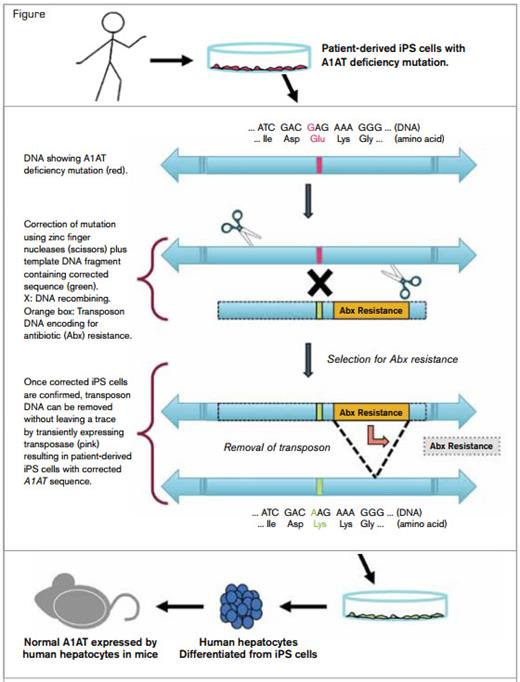Alpha-1 anti-trypsin is a protease inhibitor that protects cells from enzymatic digestion. Mutations in the A1AT gene cause liver disease or emphysema, depending on the specific mutation. The A1AT mutation most frequently associated with liver disease (known as “PiZZ”) results in the substitution of glutamate for lysine. The PiZZ form of A1AT polymerizes and accumulates inside liver cells, interfering with their normal function and leading to irreversible injury. The only effective therapy for cirrhosis due to A1AT deficiency is liver transplantation, but this potentially curative procedure is not an option for all patients due primarily to limited organ availability. In the current study, investigators aimed to develop a novel treatment for liver disease caused by A1AT mutation by using gene-corrected autologous cells.
The investigators 1) created induced pluripotent stem cells (iPSCs) from patients with PiZZ-associated A1AT deficiency; 2) designed zinc finger nucleases to specifically nick the DNA flanking the mutation in the A1AT gene; 3) replaced the region of genomic DNA containing the mutation with a fragment of DNA containing not only the corrected gene sequence, but also a transposon, which allows for selective growth of corrected iPSCs; 4) removed the transposon without leaving a trace; 5) assessed for corrected clones that had not undergone additional mutations during the procedures using deep sequencing, genome hybridization, and other approaches; and 6) differentiated the iPSCs into functional hepatocytes that were transplanted into immunodeficient mice, where they functioned to produce human albumin and the corrected A1AT protein.
The investigators 1) created induced pluripotent stem cells (iPSCs) from patients with PiZZ-associated A1AT deficiency; 2) designed zinc finger nucleases to specifically nick the DNA flanking the mutation in the A1AT gene; 3) replaced the region of genomic DNA containing the mutation with a fragment of DNA containing not only the corrected gene sequence, but also a transposon, which allows for selective growth of corrected iPSCs; 4) removed the transposon without leaving a trace; 5) assessed for corrected clones that had not undergone additional mutations during the procedures using deep sequencing, genome hybridization, and other approaches; and 6) differentiated the iPSCs into functional hepatocytes that were transplanted into immunodeficient mice, where they functioned to produce human albumin and the corrected A1AT protein.
The investigators succeeded in bringing together multiple technologies to correct the A1AT mutation without leaving any trace of the manipulations used to achieve this correction (Figure). First, they reprogrammed cells from patients with PiZZ-associated A1AT deficiency into induced pluripotent stem cells (iPSCs), taking advantage of the properties of these cells that allow them to grow indefinitely in culture. Next, they used two novel approaches to correct the mutation in the iPSC: 1) zinc finger nucleases (ZFNs) and 2) transposons. ZFNs are engineered proteins with both a customized domain that confers binding to specific DNA sequences and a nuclease domain that nicks DNA. In order to target the A1AT gene, two ZFNs (scissors in Figure) were designed – one that binds specifically upstream of the A1AT mutation and the other that binds immediately downstream. By nicking the DNA flanking the mutation, these nucleases promote exchange of mutant DNA for the correct sequence. Transposons are unique in that they have evolved to enter and then exit the genome without leaving a trace. A transposon (orange box in Figure) was used in this study to confer antibiotic (Abx) resistance upon the iPS cells that also receive the corrected A1AT sequence. Once these cells were selected based on their capacity to grow in the presence of the antibiotic, the transposon was removed without leaving behind a trace of its presence.
An overriding concern with both iPSC and gene therapy technologies is that these complex procedures can introduce other mutations into the DNA, potentially leading to unpredictable growth and possibly oncogenesis. The investigators performed extensive analyses of the corrected clones to identify those that had not undergone additional mutations. Although none of the corrected iPSC populations were entirely free of mutations, several had only a few small changes to their DNA. These corrected iPSCs were differentiated into hepatocytes that were then transplanted into immunodeficient mice and shown to be functional.
In Brief
This research provides proof of principle that gene-corrected iPSCs can be engineered successfully using gene-specific, “customized” zinc-finger proteins and transposon DNA. Gene-corrected iPSCs can be differentiated to a desired cell type in culture (hepatocytes in this example) and transplanted to treat A1AT disease. In addition to ensuring safety of iPSC-derived cell therapy, efficient protocols for hepatocyte transplantation and therapeutic repopulation will need to be developed in order for this approach to be applied clinically. This remarkable feat of scientific engineering has wide application for the treatment of genetic diseases, including, for example, those affecting patients with inherited bone marrow failure syndromes.
Competing Interests
Drs. Krause and Swenson indicated no relevant conflicts of interest.

